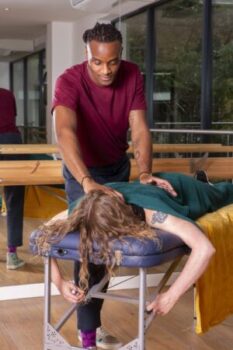Acupuncture
Acupuncture is an ancient Chinese therapy which involves single use, pre-sterilised, disposable needles which vary in widths and lengths, piercing the skin at specific points on the body. It aims to manage pain and inflammation, and it stimulates the body’s own healing chemicals in order to aid recovery.
As a physiotherapist I have studied this field as a postgraduate. I am a member of the Acupuncture Association of Chartered Physiotherapists. Most of my treatments are for musculoskeletal conditions requiring physiotherapy. More information about the association of chartered AACP more information

What can acupuncture help?
In physiotherapy we commonly use it to treat transverse planes.
- Relief of Lower back pain
- Knee Pain
- Tendon pain
- Frozen shoulder
- joint-related pain such as osteoarthritis/ Rheumatoid arthritis
- Tennis Elbow pain
- Post-operative treatment such as Back, hip, ankle, and neck
- Headaches
- Migraines
- Hip pain.
How does it work?
There are many theories. In ancient Chinese medicine they believe that there are many forces within the body that require balance in order to achieve health and fitness. This practice of inserting fine needles through the skin at specific points helps clear your energy channels (meridians) by two types of forces called YIN (negative) and YAN (positive) forces which help achieve and restore your natural state of balance (homeostasis).
In Western medicine, research has shown that acupuncture can help to reduce pain by inhibiting the pain signals transferred to the brain. It also releases chemicals such as endorphins and natural opioids which are pain-relieving substances; they also improve circulation to the healing area.
Trigger-point acupuncture may also be used to facilitate relaxation in specific muscles, or as a means to obtain increased muscle length in order to aid stretching and rehabilitation.
The aim is to determine the locations of the points, based upon your assessment. A number of needles may be used at each treatment, and these are typically left in position for 10-20 minutes before being removed.
Due to the way I work as a physiotherapist and my philosophy, we will decide if only acupuncture will be used during a treatment package, or if a combination of treatment modalities will be used to address your issue.
Frequently Asked Questions
Is acupuncture the right treatment for me?
Your therapist will ask you a series of questions in relation to your problem and your past medical history in order to determine whether acupuncture is right for you. A few reasons we might not use this treatment include a history of epilepsy, blood clotting disorders, infection or if you are pregnant.
Are there any side effects?
It is common to get a mild tingling, warmth, or heavy feeling in the area while the needles are in. The most common side effect is mild bruising; however, some people can feel a little light-headed or drowsy after treatment.
Is there anything I should do before/after acupuncture?
Try to eat a couple hours before your treatment, particularly if you have a condition such as diabetes where you could be more at risk of feeling faint if your blood sugar is low.
After treatment we will make sure you have time to sit and drink a glass of water before rushing off. You may also want to avoid driving after your first appointment in case you feel dizzy or drowsy.
If you think you could benefit from this combined approach to help your recovery from a painful condition or injury, then get in contact with your movement physiotherapist.
Ready To Book?
If you’re ready to book your appointment, simply click the button below, if you have any questions you’d like to ask before booking please contact me by phone on +44 7539 107940 or email me at kevin@kevinpowellphysio.co.uk.
ACUPUNCTURE
The central nervous system is said to be stimulated by acupuncture sites. As a result, chemicals are released into the muscles, spinal cord, and brain.
ANATOMY IN MOTION
Improve your posture and balance by tracking your movement using Anatomy in Motion activities. It shows you how your feet influence your whole posture and movement.
CRANIOSACRAL THERAPY
A gentle hands-on method that helps realign the body tissues, the bones, fascia, and muscles and helps the body to heal.
Physiotherapy Services
View More >>
Read Here To Know How Physiotherapy Can Help You
Enquire today!
Please fill out the form below, and I will get back to you as soon as possible.



